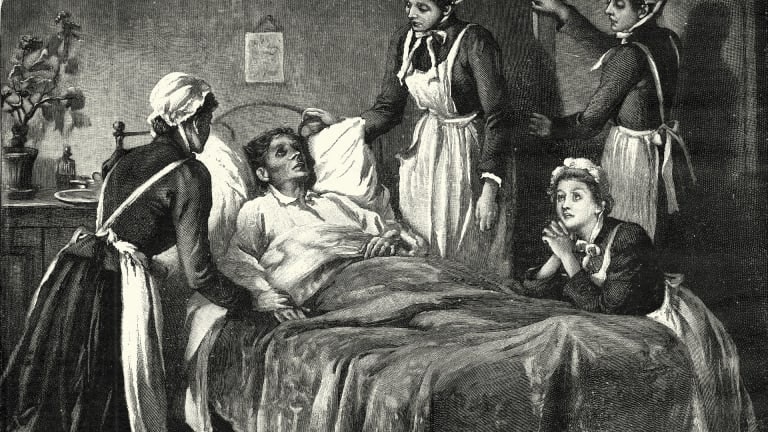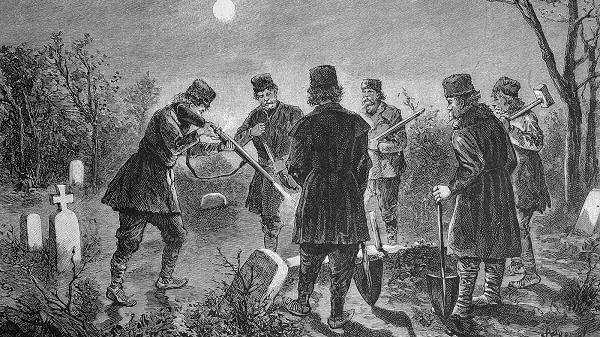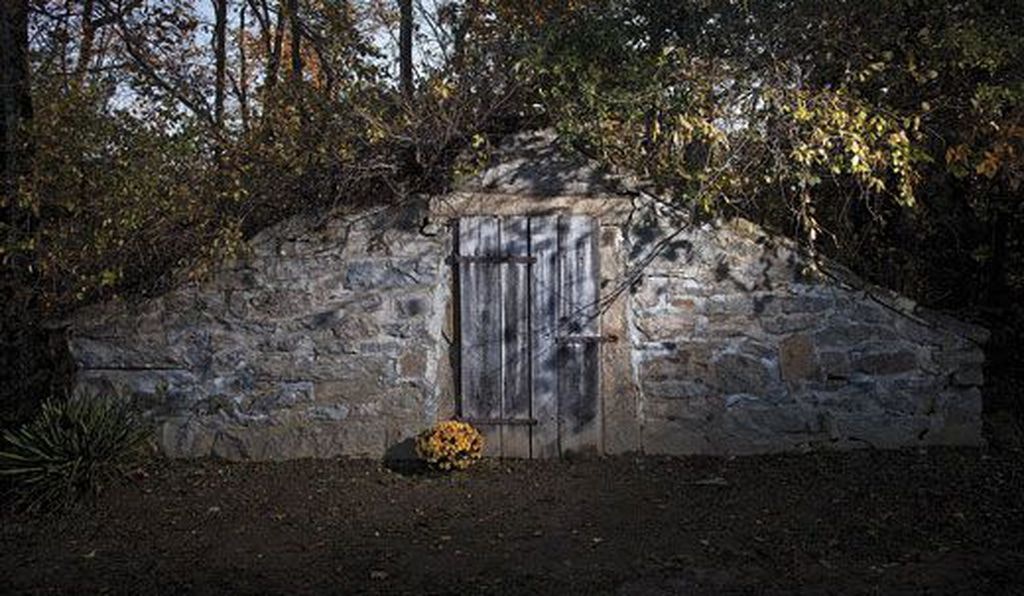Deep Dive: Vampires
By Ansley Newland
It’s early in the morning in March of 1892. The ground is still mostly frozen, and the crunch of shovels breaking through the cold earth hangs in the pre-dawn air. The community of Exeter, Rhode Island huddles together in the otherwise silent graveyard, watching as the graves of Mary Elizabeth, Mary Olive, and Mercy Lena Brown are dug up. At the head of the group, George Brown watches as the coffins of his wife and two daughters are revealed. By his side is his son, Edwin Atwood, pale, weak, and growing sicker each day.
With a groan, the three coffins are heaved to the surface. The crowd pressed close, its collective breath caught as the lid of Mary Elizabeth’s casket, beloved matriarch of the Brown family, is pried off.
Bones. Bones and dust.
A sigh of relief. Daughter Mary Olive’s coffin is next, the lid pulled back to reveal...
More Bones. More Dust.
An uneasy, relieved murmur ripples through the crowd. Perhaps they were wrong after all. Perhaps there is nothing to be afraid of. Perhaps the Brown family is just unfortunate and the undead specter of one of their own is not stalking them. As one, the group turns its attention to the final coffin of Mercy Lena, youngest daughter of the Brown family and their most recent death. With a push, the lid of her coffin slides off, slipping to the ground with a dull thud.
Mercy Lena Brown is pale as death, save for the smear of dark blood on her lips.
A gasp. An oath. A groan of dismay. At the coffin’s side, one of the exhumers looks to George Brown. Lips pressed in a line, the widower gives a tight nod. Lying in her coffin, Mercy makes no protest as the knife enters her chest. Her heart, once it’s removed, is thick with blood. Working quickly, members of the Rhode Island community build a small fire on a nearby rock. And when the wood has caught, place the bloody heart upon it. Once the flames have died down, the ashes are scraped up and mixed into a cup of cold tea. Edwin Atwood Brown, the last surviving child of the Brown family, stands in front of the open graves of his mother and sisters before taking the grave concoction-- and drinking it down.
Okay, maybe we need to start a little bit earlier to really understand just how Edwin Atwood ended up drinking his sister’s ashes on one cold morning in 1892. The story really begins with his mother, Mary Elizabeth Brown.
In December 1883, Mary Elizabeth died from a mysterious illness. Shortly after, in June of 1884, her daughter Mary Olive followed. Both women experienced the same symptoms; a prolonged draining of their strength and appetite, difficulty breathing (especially at night), and their skin growing paler as the illness progressed.
A few years after his mother and sister’s deaths, Edwin Atwood begins to suffer from the same symptoms. George Brown, desperate to save his son’s life, sends him away to convalesce in Colorado Springs, whose waters were thought to be able to heal almost any sickness.
With Edwin Atwood safe in faraway Colorado, his sister Mercy Lena starts to experience strange symptoms of her own. But where it took her mother and sister months to die, Mercy Lena died in only two weeks, in January of 1892.
Edwin Atwood eventually returns home, and despite his time spent in Colorado, he soon begins to get sick again.
This time, it was more than just George Brown who was alarmed. By this point, the residents of Exeter Rhode Island are starting to whisper about something supernatural attacking the Brown family. Each day, they grow more worried that whatever plague stalked the Brown family might soon stalk them. Talk then turns to what the cause of the Brown family deaths was--and what can be done to stop it.
The rumors and whispers culminate in that cold, morning graveyard in March of 1892 with the exhumation of three graves. All while Edwin Atwood takes a most unconventional medicine in a desperate attempt to stop Mercy Lena, now discovered to be a Vampire, from feeding off her brother and others.
The Brown family wasn’t the only family to believe that one of their own was reaching from beyond the grave to attack and feed upon their living family members. In nearby Connecticut, the Ray family of Jewett City also experienced a rash of strange illnesses, with family members slowly becoming weaker and weaker until they died. The first to die was 24-year-old Lemuel Ray, followed by the family Patriarch Henry B. Ray, and then Elisha Ray. According to newspaper accounts, when the eldest son, also named Henry, began to sicken, the bodies of both Lemuel and Elisha were dug up and burned. The remaining living Ray family members then gathered around to breathe in the ashes.
In the 1990s, a group of children stumbled upon the unmarked 1800s Walton Family graveyard where 29 graves were uncovered. However, one grave stood out from the rest. When local archaeologists removed the badly damaged coffin lid, they discovered that the body had been previously exhumed and disturbed. The skull had been dislocated from the spine and turned face down and the thigh bones were detached entirely and placed in an “x” formation directly underneath the skull.
The Brown Family, The Ray Family, the mysterious disturbed skeleton in the old Walton Family Graveyard were just three incidents in what came to be known as the New England Vampire Crisis; a very real period in time when supernatural causes were blamed for a string of mysterious and unexplained deaths. It wouldn’t be till many years later and the advancement of modern medicine that these deaths would finally be solved.
Prior to the development of germ theory in the 1860s, little was known about the way that different diseases were contracted and spread throughout communities. Even with the medical advancements of the latter half of the century, those causes would remain unknown for many living in rural communities like Exeter or Jewett City until the 1900s.
So what did the Brown Family and the Ray Family have in common? The answer is likely Tuberculosis. Tuberculosis, or TB, is a bacterial infection that most commonly affects the lungs, where it forms abscesses known as tubercles, as well as cavities, and can lead to respiratory failure. The classic symptoms of active TB are chronic cough (often with blood containing spit), fever, night sweats, and weight loss. In the 1800s, Tuberculosis was more commonly known as “Consumption,” a name that came about from weight loss, as patients were seen to be slowly “consumed” as the disease progressed. Strength, appetite, and colour of the skin fade away leaving sufferers emaciated and frail. Many of TB’s symptoms line up with vampiric myths – sufferers seem most affected at night, where lying down can make it hard to breathe. TB patients often awoke coughing with the feeling of a heavy weight on their chest as if someone had been sitting on it. Family members would slowly die one by one as the disease made its way through households, making it seem like something, or someone was killing them one by one.
The belief that someone could return after death to harm the living was not isolated to New England. In Europe, there are multiple accounts of graves being deliberately disturbed in order to stop the occupant from returning. In Bulgaria, a 13th-century grave was discovered with an iron stake driven through the corpse’s heart. And in 16th century Venice, a woman was buried with a brick in her mouth to stop her from eating through her burial shroud and returning to feast on the living. It’s likely that these European traditions were brought to North America with the first waves of colonialization and again when many European mercenaries, brought over to assist in the American Revolution, chose to settle in the new country after the war.
At one point, the panic over “vampires” was so widespread that the Boston Board of Health had to issue an ordinance in 1872 decreeing that “no person shall remove a dead body, or the remains of any such body, from any of the graves or tombs in this city, or shall disturb the dead body in any tomb or grave without the license of the Board of Health or City Council…” But by the turn of the century, the practice was disappearing as more information about Tuberculosis was uncovered. In 1882, Dr. Robert Koch discovered the bacteria behind the disease and by the early 1900s new treatments and patient isolation had led to a far lower rate of infection. In fiction, it’s a wooden stake through the heart that ultimately kills a vampire. In reality, it was medical science.
So what about that blood on Mercy Lena’s lips and in her heart? Likely her own, left over from the ravages TB wreaked upon her lungs and preserved by the cold of her grave. And what of her brother? Edwin Atwood Brown, despite the medical intervention of exhuming and consuming his sister, died a mere two months later.
If you want to learn more about the New England Vampire Crisis and other Vampiric exhumations, check out Michael Edward Bell’s fantastic book; Food for the Dead.







